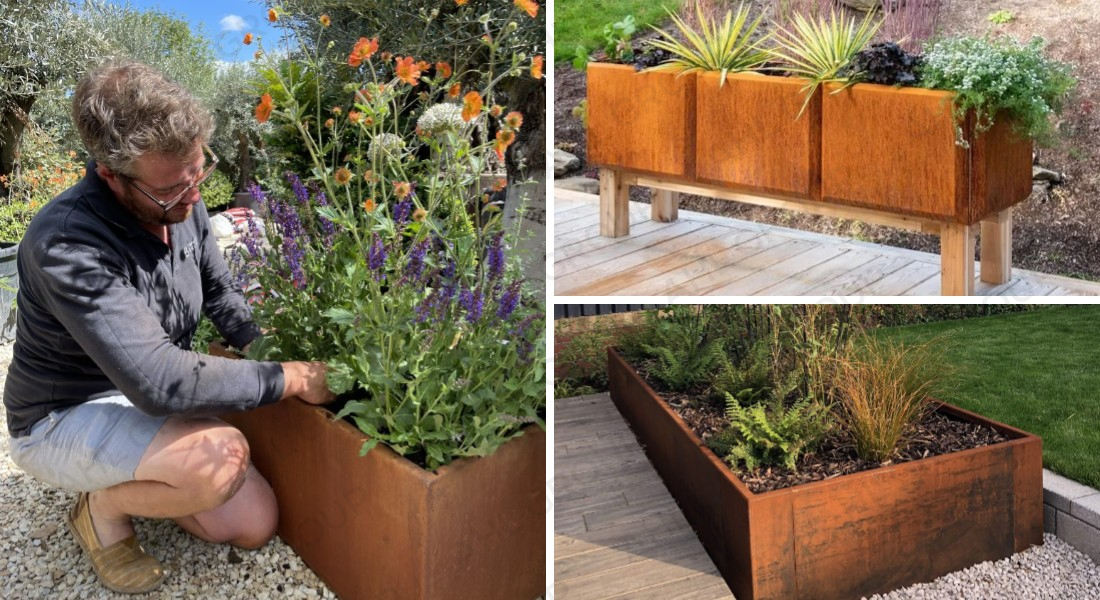Protect Beauty Of Backyard Garden: AHL Corten Steel Planters With No Staining Solutions
Popular for its durability and longevity, corten steel takes on a rust-like bronze color over time. After prolonged exposure to the elements, it develops a stable rust-like appearance. This layer of rust protects the metal underneath from further corrosion. However, there are some general concerns about corten steel planters.
Corten steel is highly regarded for its durability and longevity, taking on a rust-like bronze color over time. However, a common concern is whether weathering steel planters will contaminate and stain the surrounding concrete surface.
The rusty color on the surface of Corten planters can be soiled by rain or watering, which can run off onto neighboring surfaces or the ground, including concrete. Iron oxide particles in the runoff can adhere to the concrete. This results in staining.
2. To prevent this problem with your steel planter, AHL's product specialists offer solutions:
a. You are using brackets or posts to elevate the planter, minimizing direct contact with concrete surfaces and walls.
b. Weathered steel flower pots can be placed on the edge of unpaved decks. Adding black river rocks and cobblestones around the planter creates a smooth profile and further accentuates the color of the weathered steel. Corten steel planters will not contaminate grass and soil and, if possible, can be placed in the soil on either side of a garden path to minimize contamination of the concrete surface.
c. During the initial rusting period, the area around your corten planter pots can be cleaned regularly to remove any traces of runoff residue so that it does not contaminate the concrete on the wall or floor.
...
 These suggestions provided by AHL's experts will hopefully provide effective help for your planter, so that you can enjoy the aesthetic effect of steel planters while not having to worry about corten steel planters staining concrete surfaces.
Another important consideration is whether corten steel garden pots are harmful to plants. Happily, AHL weathering steel planters are generally harmless and environmentally safe for plants.
These suggestions provided by AHL's experts will hopefully provide effective help for your planter, so that you can enjoy the aesthetic effect of steel planters while not having to worry about corten steel planters staining concrete surfaces.
Another important consideration is whether corten steel garden pots are harmful to plants. Happily, AHL weathering steel planters are generally harmless and environmentally safe for plants.
Over time, weathering steel forms a layer of rust on the surface, which acts as a protective barrier against further corrosion and can minimize the possibility of any potentially harmful substances being released into the soil.
 However, it is also vital to ensure that there are proper drainage holes to remove sewage, as standing water can accelerate corrosion and potentially leach small amounts of rust into the soil. Although, small amounts of rust are usually harmless and do not greatly affect the pH or nutrient availability of the soil. However, AHL product experts recommend proper drainage: Make sure your weathering steel planter has adequate drainage holes to prevent standing water.
However, it is also vital to ensure that there are proper drainage holes to remove sewage, as standing water can accelerate corrosion and potentially leach small amounts of rust into the soil. Although, small amounts of rust are usually harmless and do not greatly affect the pH or nutrient availability of the soil. However, AHL product experts recommend proper drainage: Make sure your weathering steel planter has adequate drainage holes to prevent standing water.
Regularly check the pH of your soil and adjust as needed to maintain a healthy growing environment for your plants.
In summary, concerns about concrete staining and plant safety are legitimate, but AHL’s expert advice ensures these issues are managed effectively. So rest assured that AHL weathering steel planters are safe for plants and contribute to a sustainable environment.
.png) For more information or to place an order, you can always contact us. AHL’s team of experts are ready to assist you in choosing the perfect weathering steel planter for your garden.
For more information or to place an order, you can always contact us. AHL’s team of experts are ready to assist you in choosing the perfect weathering steel planter for your garden.
Back

 However, it is also vital to ensure that there are proper drainage holes to remove sewage, as standing water can accelerate corrosion and potentially leach small amounts of rust into the soil. Although, small amounts of rust are usually harmless and do not greatly affect the pH or nutrient availability of the soil. However, AHL product experts recommend proper drainage: Make sure your weathering steel planter has adequate drainage holes to prevent standing water.
However, it is also vital to ensure that there are proper drainage holes to remove sewage, as standing water can accelerate corrosion and potentially leach small amounts of rust into the soil. Although, small amounts of rust are usually harmless and do not greatly affect the pH or nutrient availability of the soil. However, AHL product experts recommend proper drainage: Make sure your weathering steel planter has adequate drainage holes to prevent standing water..png) For more information or to place an order, you can always contact us. AHL’s team of experts are ready to assist you in choosing the perfect weathering steel planter for your garden.
For more information or to place an order, you can always contact us. AHL’s team of experts are ready to assist you in choosing the perfect weathering steel planter for your garden.